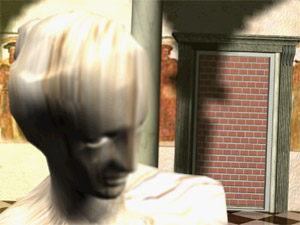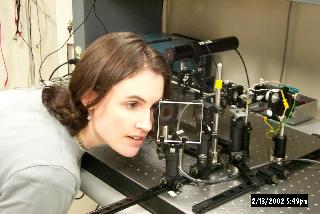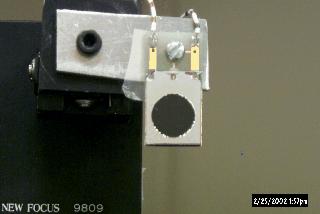True 3D Displays
The goal of this research is to develop a visual display that mimics
natural 3D viewing, unlike most all stereoscopic displays available today.
 |
An illustration of software defocus cues for an
accommodative
response. Move your pointer
between foreground and background to
see
the difference in focus. |
The eye captures two-dimensional (2-D) images on the retina and the human
mind perceives distance or depth by using the many available depth cues.
Each eye can focus at various fixation distances by changing the shape of
the crystalline lens (accommodation) to minimize blur and by changing the
relative eye position (vergence) to eliminate double vision.
Accommodation and
vergence are the most important physiologically
driven processes of the eyes involved in viewing real three-dimensional
(3-D) objects and they are linked with one another at a muscular reflex
level. An involuntary movement in one cue is triggered when the other
process is moved, such as converging the eyes to see an object up close
(vergence cue) triggers the eyes to focus closer than previously
(accommodation cue).
 |
| Monocular true 3D display apparatus |
Current electronic 3-D displays do not match the accommodative and
vergence requirements of our human visual system for viewing objects in
depth and violate this linkage. Standard stereographic displays provide
two disparate perspective views that must be actively fused via vergence
by the viewer to display objects that appear at distances other than
that of the fixed-plane image display. Users must uncouple the natural
response of accommodating in concert with these vergence shifts to the
changes in apparent distance and instead maintain a fixed focus on the
display surface. The conflict that occurs between the accommodation
depth cue and the stereoscopic depth cue is documented as one of the
leading causes for discomfort when viewing 3-D displays.
 |
| 10mm
diameter MEMS deformable mirror |
The elimination
of this cue conflict in prototype virtual retinal displays is
hypothesized to be able to alleviate fatigue when viewing 3-D displays.
The accommodative cue will be generated in hardware using
wavefront shaping deformable membrane
mirrors.
In addition, software cues, such as blurring, relative
size, occlusion, etc., will be tested for triggering appropriate
accommodative responses in electronic 3-D displays. Our prototype
electronic display that allow for both accommodation and vergence we
call "true 3D" displays since it allows the viewer to see in 3-D more
naturally that current stereographic displays. We anticipate that these
more natural true 3D displays will reduce viewer fatigue and make a more
compelling visual experience.
Sponsoring Agencies
Intel Corporation
National Science Foundation Bioengineering MRI Program, NSF/BES grant number 0421579
Contacts
Brian Schowengerdt <brian hitl.washington.edu>, Eric Seibel <eseibel
hitl.washington.edu>, Eric Seibel <eseibel hitl.washington.edu>
hitl.washington.edu>






![]() hitl.washington.edu>, Eric Seibel <eseibel
hitl.washington.edu>, Eric Seibel <eseibel![]() hitl.washington.edu>
hitl.washington.edu>